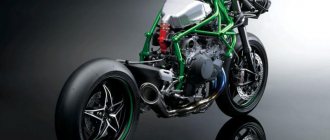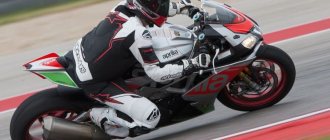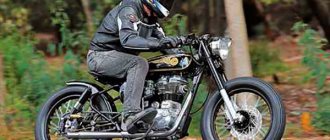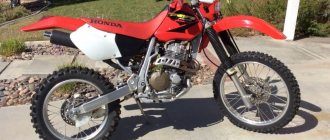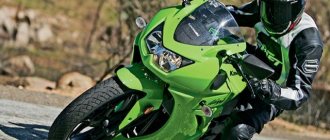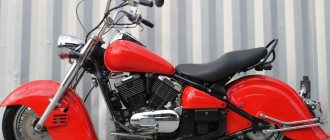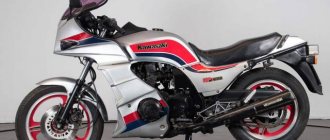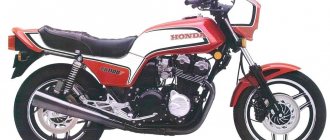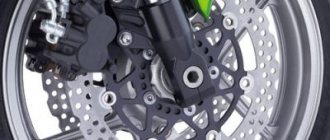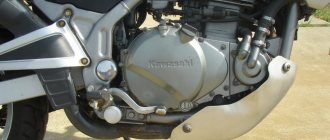Dimensions and weight
The weight of the model without fuel is 233 kg. This is a relatively large weight for a sports touring motorcycle, but the bike’s power is considerable. The gas tank capacity reaches 24 liters. Even taking into account the fact that 6 to 10 liters of fuel can be spent per 100 km, the capacity of the gas tank may be enough for a good trip with only one initial refueling. The rear tire dimensions are 180/55 VR17, while the front tire dimensions are 120/70 ZR17.
Review of the Kawasaki ZZR 1100 (ZX-11 Ninja) motorcycle
Before purchasing, I rode a season on a ’91 Kawasaki ZZR-400, which I was extremely dissatisfied with. To be honest, apart from its tolerable appearance for such an old man, I don’t remember any other advantages - heavy, low-power, slow-moving, gluttonous. In short, the new Kawasaki ZZR-1100 arrived on time. Let me say right away that the condition of the motorcycle was so-so. As it turned out later, this is rather the rule for this model. The pads, spark plugs, brake discs, chain tensioner were worn out, the brake calipers were soured, the cord was coming out of the rear tire, and the damper in the rear wheel was broken. Everything except the pads, spark plugs and tires - . After generous financial injections, the old man came to life. On the plus side, it’s a very comfortable and quite playful motorcycle – the speedometer shows 275. The Kawasaki ZZR-1100 is very stable at high speeds - cruising speed is 180 - 200 km/h. The landing is almost straight, you need to lie down after 200 km/h. Very moderate gasoline consumption. The plastic is incredibly durable, thick and does not easily rub off on asphalt. There are no covers sticking out, and therefore there is almost no chance of breaking the motor when dropped. From below, the engine is securely covered by the exhaust manifold. Pleasant sound after 8000 rpm. Adjustable suspension - rear and front spring preload and compression damping.
Very large tank volume. Excellent energy consumption of suspensions. The fork seals stand up well to the tests of our roads. Very rigid and durable frame. The motorcycle absolutely does not require a steering damper.
Disadvantages - the light is complete bullshit, the turn signals break for any reason and cost some astronomical money, the speedometer has very small digitization and is almost unreadable at high speeds, the engine is very noisy. The tank is made of ordinary “rust steel”. The brakes are sluggish - and this is after replacing all the rubber bands in the brake drive with new ones! The need to adjust the valves every 10,000 km (the next consequence is a decrease (!) of the gaps over time. When they disappear completely, the valves will burn out.) It is necessary to constantly synchronize the carburetors. The Kawasaki ZZR-1100 is very reluctant to stand on the rear wheel; it is not structurally able to stand on the front wheel. Vibrations from 8500 to 9000 rpm. Very inconvenient to maintain - for any reason you need to remove all the plastic.
A separate point is controllability. The Kawasaki ZZR-1100 requires a deep understanding of the processes occurring in it. With stock settings it doesn't turn at all. I had to tighten up all the settings. After that, everything improved significantly, but the comfort disappeared completely. Counter-steering is the only way to quickly change direction. In this case, you have to make a lot of muscle effort. Hiking along the winding old Moscow road is akin to a good workout in the gym. At reasonable speeds this only amuses, besides, after turning into a turn, the zizer becomes incredibly stable, and no pit or bully can bring it out of this state. Skidding on this long-wheelbase motorcycle looks like innocent fun. If you don't let off the gas, it will easily stabilize itself. By the way, the gas must be constantly kept open when turning - the soft front fork is not capable of bearing significant loads. Unfortunately, an increase in speed is accompanied by an increase in the forces that need to be applied to the motorcycle. And when at a speed of under 200 in a gentle turn you have to make a lot of effort, it becomes very scary.
I ended up buying a fireblade. I'm interested in turns, but I got tired of driving in a straight line in the first year.
Why so long? Because I drove it for 3 years. Bottom line - yes, the Kawasaki ZZR-1100 has many strengths and many weaknesses. But objectively, this is the only way to enter the world of liters at the price of four hundred.
I wanted a liter; in my youth I looked at photos of this powerful handsome man in foreign magazines). Now 29 years old, a lot of experience in motorcycle technology behind me. I started like everyone else at the age of 16, owls, sunrises, Javas, donkeys)). I drove them for 8 years, it’s time to switch to the Japanese, first I tried: Honda CB400, Suzuki impulse 400, zzr400 and 1 and 2 oh. Next are Khizhir 1200 and 1300. After my friend bought a ZZR 1100, I immediately bought one for myself).
So:
It's going down. Powerful. Acceleration is like a cannon, it doesn't bother you. 1 up to 120 km/h, 2 up to 170.3 up to 210..., I don’t remember the rest because I didn’t have time to look at the tidy). As a result, I reached 275 km/h with the passage! Consumption 10 liters per hundred! In floor mode! To hundred in 3.5 from a standstill and 9 seconds to 200. Heavy, weight 250 kg!!!!!!!! Well, that’s good) it holds its trajectory like a diesel locomotive! I don’t really like the way it turns, it tries to go into oncoming traffic. The brakes are not the best, they could have been better equipped. 150 forces sweep from any gear, and from any speed! Many will rest already at the start!!!!! The box is not the most accurate, but you get used to it. The sound is simply amazing!! My height is 195 cm and 110 kg, I sit freely, relaxed, powerful wind protection up to 250 km/h! In the rain you can fry 170-200 easily! I don’t recommend it for dead people, because you won’t even be able to put it on the step! Reliability is excellent if the device is initially ideal. I only changed filters, oils, pads and fork seals.
The fall of 2011 came and I decided to sell my Kawasaki zr-7 (a review has been written) and buy something more powerful and more windproof.) During the winter I decided on the models, these are: Kawasaki zx12r, zzr1200, zzr1100. I wanted a sport tourer with a powerful engine and good wind protection. Having accumulated the required amount, I began to intensively monitor the Internet. The preference was zx12r, but there were no adequate price tags.... either firewood or inflated prices, but I didn’t want to overpay. There was not a bad offer for the zx12r, but the seller was stupid and I decided to refuse, the zzr1200 was also inspected, I didn’t like its condition either. And already in April I decided to stop at zzr1100 because... The offer wasn’t bad, and the snow was almost gone and I really wanted to go skiing! In the end, we went, looked, bought! It was 400 km from home, so it was time to get comfortable and get used to it. After filling out the paperwork and paying, we went home. First impressions are that the bike is very wide and you have to reach for the steering wheel, but at the same time the seating position is comfortable. Having driven out onto the highway I immediately appreciated the stability, the bike goes like a glove. Somewhere after 200 km of travel I already felt numbness in my body, then this feeling came more and more often (it was winter and I was not used to this class of motorcycles). When I got used to it, I tried to unscrew it to 9t/rpm with the second one, the sensations are indescribable! I slid almost into the back seat and, clutching the steering wheel, quickly slowed down. When I got home, I barely got off the bike, my whole body ached, my hands hurt. but the delight remained) Then the 2012 season went into full swing. Every good day I went on trips from 50 to 350 km, long-distance trips were in the plans, but... it never happened. Every time I went out for a ride, I could not get enough of its power, wind protection and stability. I had a high glass and at 160-180 km/h I didn’t have to bend down, but at 140 km/h it was absolutely awesome (my height/weight is 187/85). There was always enough power, it’s very nice to overtake and know that you will always have time, this never happened on the zr-7. Once I quickly accelerated with the second number from a standstill to 80 km/h, so then his hands were shaking))) Many people write about being reluctant to take turns, I can say that everything is fine with him, it’s just a sport tour and not a sport -bike, so it should be assessed as a heavy sports tour. For me, it always entered and exited turns along a clearly defined trajectory, both at 60 and at 160 km/h, you just need to soberly assess your capabilities and speed, and not try to do the impossible. The maximum I accelerated on it was 220 km/h, because... I’m not a fan of frantic pace and speed records, I prefer a comfortable and at the same time fast ride, but I think it will go 300 km/h. At speed, the bike behaves perfectly, it doesn’t throw or wobble, it just lies down on the tank and rolls 200+ and that’s it. I didn’t really like the brakes, they slow down 250 kg well, but it feels like they’re kind of weak (maybe it’s just like that on mine). The more I rolled into the moto, the more I got used to the landing. The seating position is, in principle, comfortable, especially at speeds over 200+, and you don’t need anything else, but my hands still ached after long trips. Driving with the second number does not cause any inconvenience. I didn’t like the headlights; I wasn’t very confident in driving in the dark. Instrument readings are easy to read at any time of the day. The engine and gearbox operate smoothly. Many people criticize the Zizer gearbox; on my motorcycle it worked very smoothly and clearly. Of course, there are those who buy zizers that have been killed in the trash and even squeeze everything out of it, thinking that there is a fresh sport underneath and they naturally break down, and then they spit in the direction of zizers and the Kawasaki company in general. I can say that this is already my 5th motorcycle from this company and everything went well, didn’t break down and brought only pleasure. More than once I had to drive through Moscow traffic jams, both very thick and thin) I can say that it is quite normal. Of course, when you stand for a long time in dense traffic jams where you can’t drive between one row and all the time you have to change lanes from row to row and often work the clutch and brake, then of course your hands buzz, but this bike is not really for that. If you only ride around the city, then of course you need to consider another motorcycle. About putting it on the rear step - it’s very easy to put it on (some people just write that you won’t put it on). Once it fell near my garage, I picked it up alone without any problems. Once we went to the Volga: forest, sand, mud, huge puddles and holes, and this road was about 10-15 km long. Of course, the Zizer is not at all for such roads, but even on them I drove quite normally. It’s true that I got tired of washing it later, especially the radiator. Its tank is 24 liters, and when driving 140-180 km/h the consumption is 6-7 liters per 100 km, so the tank is enough for 300-350 km, and if you drive 120-140 km then even more. The suspensions are good, it is a sport tourer, but when cornering on bad asphalt at speed the bike wobbles a little, which is affected by the long wheelbase and soft suspensions. There is a very small glove compartment under the saddle; there is room for a small bottle of lubricant, a tool, and a rag. So the case is a very useful thing! During the season I drove about 8k, there were no breakdowns. I sold it in the fall. Of course, I didn’t really want to sell, but I needed money. In the winter I bought a zrx1100 for the occasion, so I’m waiting for the season.
To summarize, I can say that the Kawasaki zzr1100 is a very good and powerful motorcycle. From the design, of course, it is clear that it is from the 90s, but its potential still amazes us today. This motorcycle undoubtedly deserves respect. If you use it for its intended purpose, it will bring only positive emotions.
I bought this super motorcycle (for 135 thousand rubles) via the Internet and, one might say, blindly, i.e. solely from the photo. In Russia I was the first owner, and from the Japanese owner I got a direct-flow 4in1 exhaust, reinforced hoses, tinted glass, as well as soured brakes, a broken piece of plastic, oak tires and a dead battery. The motorcycle arrived in November, and therefore, in order not to suffer from motorcycle toxicosis, I spent the winter in a warm box next to the motorcycle. As a result, I adjusted the valves i.e. I removed the washers and trimmed them to the required size on a diamond wheel, nothing complicated. I cleaned and adjusted the carburetors, fortunately, the whole process is described on the Internet, there is even a video, I also overhauled the brakes, replaced all the fluids and filters. Closer to spring, I had all the plastic repaired and painted, so I was ready both visually and mentally for the opening of the season.
First departure. In the winter I started it up and appreciated the sensitive response to the throttle, so while I was driving out onto the main road everything was fine, BUT as soon as I got on the highway and at the first overtaking I almost “fell apart” because... the bike just started to grind and go into a skid, let off the gas - it stabilized, its back was damp and it drove home in a “whisper”. During the evening I rode on a deserted highway. He sang, shouted, cried with happiness, stopped, smoked nervously, again accelerated in the “cutoff” mode, braked sharply, smoked nervously again. The next day I came home just to have a snack. The first two weeks flew by at a speed of 0-220 km/h. Afterwards there were bike rallies, rides with friends, but the impression remained unchanged of the moto-BULLET and it doesn’t matter whether you are alone or with a passenger, the feeling of controlled power never leaves.
Who would I recommend? A pilot with his head on his shoulders because... almost 150 horses per 240 kg of weight is a lot, of course the spendthrift forgives mistakes, but it’s clearly not worth abusing it.
Why did I sell it... My wife was very worried when I left, I only took it for a ride once (as an asshole) and that’s it, I was leaving abruptly and she “would come back or NOT.” This is how I got a “shadik”, but more on that another time. Now I am “sick” with Drozd.
Chassis and brakes
The bike has an aluminum frame with a very stylish design. Indeed, the exterior of the Kawasaki ZZR 1100 is several times ahead of the class average. This is one of the most elegant sport-touring motorcycles in history. Of course, the wheels are alloy. The comfortable steering wheel has average dimensions for the class.
The rear suspension is a progressive monoshock absorber. Suspension travel is 112 mm. At the front, a telescopic fork with dimensions of 43 mm is used. Its stroke is 120 mm. The rear brakes are a single 250 mm disc with a single-piston caliper. The front brake consists of two 320 mm discs, accompanied by four-piston calipers.
Comfort
The Kawasaki ZZR 1100, whose technical characteristics are conducive to long and fast trips, is stable on the highway and comfortable for long trips. This is evidenced by numerous reviews.
The pilot's position is comfortable; he has to lie down on the motorcycle at speeds close to two hundred. Good wind protection minimizes the influence of oncoming air currents.
The passenger seat is normal, traditional for the sport class. Its dimensions are very modest, but this feature is inherent in most motorcycles in this category.
Brief history of the model
1990 – start of production and sales. First generation. Model: Kawasaki ZZ-R1100 / Ninja ZX-11 (Europe, North America). Factory designation: ZX1100-C1.
1991 – minor changes in the intake design and carburetor settings. Model: Kawasaki ZZ-R1100 / Ninja ZX-11 (Europe, North America). Factory designation: ZX1100-C2.
1992 – improved design and strengthening of gearbox components for greater resistance to increased loads. Model: Kawasaki ZZ-R1100 / Ninja ZX-11 (Europe, North America). Factory designation: ZX1100-C3.
1993 – restyling of the model. Second generation. The first generation (C4) with a gearbox from the second generation (D1) is also available in parallel on the North American market. The model slightly changes its appearance and receives the following technical changes: extension of the gearbox output shaft; due to frequent problems with gearboxes on first-generation models, gear ratios were changed and changes were made to the design; the size of the filter box has been increased; increasing the fuel tank capacity from 21 → 24 l, adding a reserve light; increase in dry weight 228 → 233 kg; the crankshaft and piston designs have been changed (to increase service life); the oil channel in the cylinder head has an elliptical shape (improving the flow of oil and lubricant); The wheel size has been slightly changed; new frame – die-cast, more rigid, frame technology taken from the ZXR750; changes in the brake system - an increase in the diameter of the front discs 310 → 320 mm, the rear caliper becomes 2-piston. Model: Kawasaki ZZ-R1100 / Ninja ZX-11 (Europe, North America). Factory designation: ZX1100-D1.
1994 – no significant changes. Model: Kawasaki ZZ-R1100 / Ninja ZX-11 (Europe, North America). Factory designation: ZX1100-D2.
1995 - European versions receive a 4-tooth rear sprocket (instead of 45), changes were made to the exhaust (improved sound insulation) to meet new European noise standards, and a digital clock appears on the dashboard. Model: Kawasaki ZZ-R1100 / Ninja ZX-11 (Europe, North America). Factory designation: ZX1100-D3.
1996 – no significant changes. Model: Kawasaki ZZ-R1100 / Ninja ZX-11 (Europe, North America). Factory designation: ZX1100-D4.
1997 – no significant changes. Model: Kawasaki ZZ-R1100 / Ninja ZX-11 (Europe, North America). Factory designation: ZX1100-D5.
1998 – no significant changes. Model: Kawasaki ZZ-R1100 / Ninja ZX-11 (Europe, North America). Factory designation: ZX1100-D6.
1999 - the model receives a black frame. Model: Kawasaki ZZ-R1100 / Ninja ZX-11 (Europe, North America, Asia, Australia). Factory designation: ZX1100-D7.
2000 – North American model only available. Model: Kawasaki Ninja ZX-11 (North America). Factory designation: ZX1100-D8.
2001 is the last year of production. Model: Kawasaki ZZ-R1100 / Ninja ZX-11 (Europe, North America, Asia, Australia). Factory designation: ZX1100-D9.
Among the main advantages of the machine:
- high performance of its engine;
- tubular steel frame;
- nice unobtrusive design.
The Kawasaki ZRX 1100 even slightly exceeds the standards accepted in the class. It has an engine borrowed from another 1100 cc bike from the concern - the sports touring GPZ 1100. The engine has been derated, while the torque has been increased in the mid- and low-speed range.
There are two versions of the Kawasaki ZRX 1100: 1100-1 with a rectangular headlight and front half-fairing, and 1100-2 without a half-fairing and with a round headlight. The second version is considered classic. The motorcycle did not last long, but during this time it managed to show its best side.
